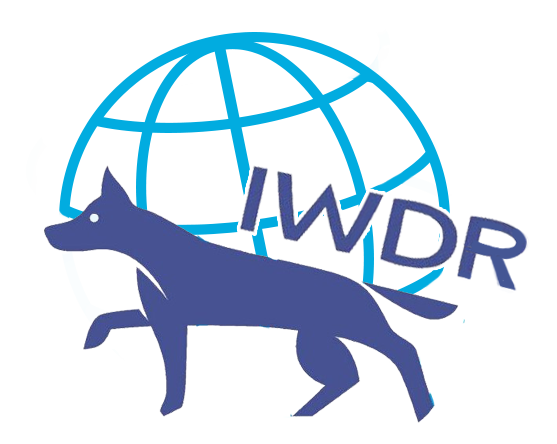Early Socialization - Week 3 - 14-21 Days
![]() TIP: Click the quick-links above to go directly to each section. You can also click the anchor icons at each section to return to the top of the page.
TIP: Click the quick-links above to go directly to each section. You can also click the anchor icons at each section to return to the top of the page.
Quick Reference Guide:
Goal:
Add variety in body handling, develop hearing skills & confidence in new environments
Environments:
Den, or brief 1-on-1 excursions outside den with a familiar handler. Should another room not be available a puppy-proofed area that is able to be sanitised between litters is also suitable.
Volunteer Type:
Experienced or staff only (note brood’s comfort levels)
Introduction
Rapid physical and behavioural development occurs this week. As pups become more mobile and extend their exploration of their den utilise this time to offer more variety and challenges for the pups.
- Body handling will offer more variety in items used.
- Massage continues to build up a positive human relationship as well as pups learning to cooperate with humans and not wiggle when being held or handled.
- Their sense of hearing is improving so this week gently build skills around hearing.
- Promote confidence and calm acceptance of unfamiliar environments
- Use a familiar handler if pup is taken briefly outside the den for 1 on 1 away from littermates.
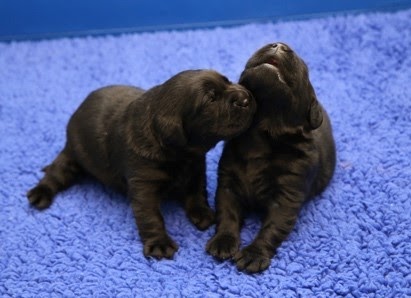
- Addition of unfamiliar sounds, surfaces, textures accepted without issue.
- Calm acceptance of massage and textures over body.
- Pup is in the engaged (Green) zone most of the time,
Pup’s confidence will increase as it interacts and learns that its environment is constantly changing
- Alternatively, pup is in the conflicted (yellow) zone briefly then moves back into the green zone once it has resolved the internal conflict.
Pup displays 1 or 2 stress signs (yawning, whining) it quickly resolves inner conflict without escalating to additional stress signals; Second exposure pups are more confident with a reduced number of stress signals. Look for an improvement in the pup’s confidence with each exposure to the stimuli. If the pup has displayed 2 or 3 stress signals, set pup up for success and aim for less next time by building the pup’s confidence.
Tip: Review the material on Handling for more information on these zones and how to measure the puppy’s response to stimuli.
Pups still need large amounts of sleep. Do not over stimulate the pup. It cannot learn in this mode
Utilise the natural curiosity of young pups when introducing new environments and build up positive association around change prior to the startle/fear stage that occurs later.
Observe pup and adjust procedure appropriately so it is a positive learning experience. Each pup is worked as an individual and techniques are for this pup not the whole litter.
Early repeat exposure in different environments will add to pup’s confidence and ways to resolve inner conflict.
Keep it brief: Remember pups have short attention spans. A successful exposure may be only seconds long and an entire education session should be no more than 5 minutes.
Keep your objective in mind: Since puppies have short attention spans, it is important to focus on the task at hand. While it is very tempting to snuggle a puppy before working with them, this can take away from the puppy’s purposeful learning for the day as they are able to work for noticeably short periods of time
Give the puppy an “escape route”: When an activity has gone on too long, is too overwhelming, or too challenging, a puppy needs a means to avoid it. If a puppy uses the escape route frequently, stop and seek assistance. Large objects, tunnels, gap behind crate can offer a pup a safe area to resolve their inner conflict.
Adaptability is an important skill in working dogs. Teaching pups to accept daily changes in environment, handling and routine during this age group will help them generalise to any environment in their working life.
Teaching pups to interact with their environment without overreacting is an important skill in producing sound working dogs.
Teaching these skills during the early critical learning period will produce better results than introducing it after 12 weeks of age when pup is not as adaptable to changes.
Increasing the pup’s repertoire of positive associations around new and novel objects and environments will result in resilient dogs.
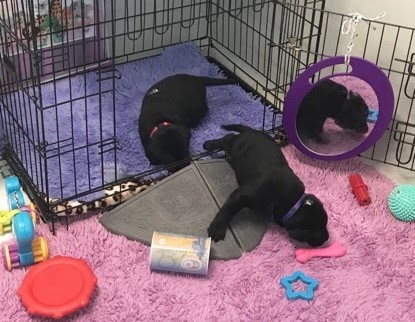
Problem Solving
- Allow pup time to resolve inner conflict themselves
- Offer emotional support via voice and touch
- Shorten duration of visit. If one pup displays distress signs (whining) the others will usually follow. Be prepared to move when all pups are quiet so as not to reinforce a negative behaviour (whining gets what I want)
- Engage with pup using favourite toy
- Look for an improvement in the pup’s confidence with each exposure to the stimuli. If the pup has displayed 2 or 3 stress signals, set pup up for success and aim for less next time by building the pup’s confidence.
- Has time been spent with the Brood prior to her Whelping in order to build up positive associations? Pre-whelp is a good time to massage the Brood especially around her side and towards her glands where pups will feed. Relaxation music can be helpful as well as introducing the Brood to the initial sounds her pups will experience once their ears open.
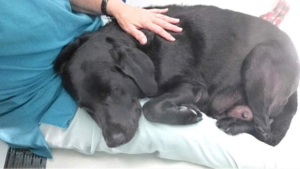
- Look at protocols used in handling.
- Are pups touched prior to being lifted off ground for weighing?
- Ensure all staff move pups slowly and absolutely no flying quickly through the air.
- Ensure that the massage is no longer than 1 minute. Reduce time then slowly build up again.
- Place another pup next to the pup being massaged for a familiar scent.
- Use a small piece of whelping mat that has been left under puppies. Familiar scent will be on the massage whelping mat.
Encourage mom to come near the puppies and interact with the items. If puppies continue to show stress signs, return puppies to their den with Mom and try a shorter amount of time next time.
Stop and place hands around pup’s chest area. Do some gentle circular motion with your hands. Once pup is calm again you can resume the body handling.
It can help to go back to an area on the body that pup is comfortable being handled and try again.
Should pup still not be comfortable reduce the session times then build up again.
Try luring with slower, more deliberate movements. Make sure you have pup’s interest in the lure and maintain that connection. Practice moving your arm with a “mixing bowl” movement – wide, sweeping and steady.
Passive Environmental Enrichment
Passive exposure continues by exposing pups to a variety of surfaces, sounds, movement, objects in their crate and den environment.
Acceptance of change and difference can be achieved by placing 1 random object into the nest each day that the puppies have not been exposed to before (backpack, hat, purse, statue like objects). Observe and record each pup’s reaction to novel object.
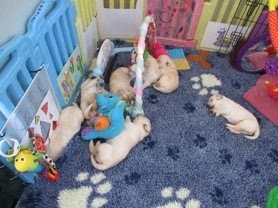
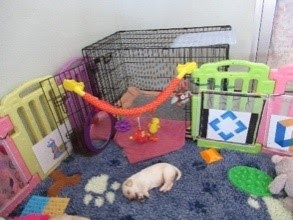
Note this video covers multiple age groups. Please see the section from 1:16 – 3:07 for content appropriate for this age group.
- When exposing pups to new sounds, think about variety. Music can include jazz, classic, country, pop, or simply putting on the radio.
- Playing the news or weather report on the TV or radio exposes pups to different voices and different types of sound.
- Music can be played quietly on a radio or computer in the same room as the whelping box for half an hour per day.
- Safe objects that make noise can also be placed in the whelping box.
- If Mom is uncomfortable with items or will chew items up, only place them in the den under supervision for a short period of time.
Hand-held sounds items as well as interactive sound objects can be used during this activity. Below are age-appropriate examples for both hand-held objects as well as other sound items that puppies can interact directly with.
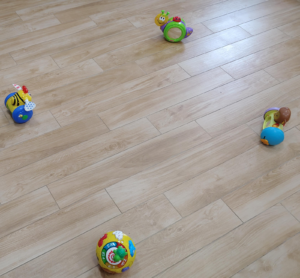
Goal: To allow puppies to explore multiple sound objects with a handler and to be comfortable with a variety of sounds.
To prepare the designated space for this curriculum, please complete the following steps.
- Gather 5 noise objects and 2 handheld noise objects. Remember variety when selecting objects.
- Place the handheld noise objects on a nearby counter or out of puppies’ reach.
- Arrange the objects in a circle spread apart enough for the puppies and handler to move around comfortably.
You are now ready to retrieve the litter of puppies you are working with.
- Allow the puppies to explore the room upon entering for up to 30 seconds.
- Use the hand-held noise objects when the puppies are playing and exploring the room.
- Encourage the puppies to explore each of the objects with you.
4. Continue around the circle in the same manner
Continue to add new surfaces each day or change the placement of the surfaces
- Smooth slippery surfaces are not suitable as this age as pups have only started walking and will be unsteady on their feet
- Passive crate exposure, uneven surface (ramp into crate), small red wobble toy, tin that rolls, a mirror can be added to den to provide variety
Add more variety as the pup’s eyesight improves by the use of visual stimulation walls or by changing the location of items around the room.
- Hanging mobiles for passive coat desensitisation and noise – change the position each day, then add a new hanging toy and repeat the process throughout the week.
- Change to new visual pictures on the wall or change position around the room so the pups environment is constantly changing. Acceptance of change will help to build a resilient dog.
Working dogs must be accepting of a variety of novel objects they may encounter in the community; so, it is important that at an early age they begin to build their reference library of unusual items, including those that move, so that they are comfortable and confident with different novel objects.
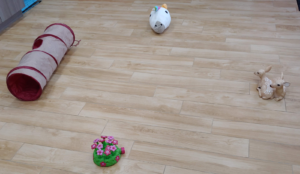
Novel Objects Protocol
Goal: To allow puppies to explore multiple novel objects with a handler and to be comfortable with novel objects.
To prepare your designated space for this activity, please complete the following steps.
- Gather 5 novel objects. Remember variety when selecting objects.
- Arrange the objects in a circle spread apart enough for the puppies and handler to move around comfortably.
You are now ready to retrieve the litter of puppies you are working with.
- Allow the puppies to explore the room upon entering for up to a few minutes (consider needs of the puppies!).
- Invite the puppies to explore each of the objects with you.
- Continue around the circle in the same manner.
Ensure you introduce a large variety of new people, start gradually to build up pup’s acceptance of difference. Demographics to cover include; young, elderly, male, female, toddlers, different ethnic groups
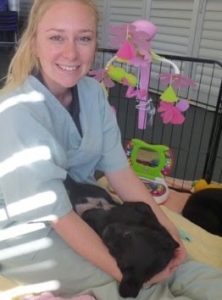
Interactive Activities
The development of purposeful play will start this week (pups become aware of Brood and litter mates this week so will see more puppy like behaviour) with littermates exploring novel objects, sound objects, motion objects, and surfaces.
Start with soft gentle sounds, like baby rattle, as ears are not fully opened. Add more variety of items so pups will continue to develop positive experiences around body handling, and puppies can build positive association with new objects and sounds. Every interaction with the puppies continues the building of handler engagement.
It is important to start to build a solid foundation of skills. Body Handing is ongoing and involves lots of practice. It can be done in short sessions throughout the day in order to set the pup up for success by keeping skill training fun and expectations consistent. Body handling is the process of teaching our puppies to accept all parts of their body being handled while remaining calm while we touch and move all parts of their body.
This is beneficial for health/Vet visits. These skills also help with body sensitivities to equipment the pup may need to wear such as boots or coat.
Remember, Body handling should be a calm, gentle process – it’s not a time for cuddles or play – that can come later! Take extra care around your pup’s teeth, ears and paws – these areas are crucial for Body Handling but many pups find the handling of these areas strange at first.
Start by Teaching the “Close” position: (Note at younger ages puppies may need to be put in this position to begin the exercise. With age, pups can be taught how to manoeuvre into that position using the lure as described below.)
- Start by crouching on the ground with the puppy in front of you, facing you.
- Place your right knee on the ground – If pup is on a lead put the lead under your knee so both hands are free 3. Use your left hand to lure the pup from your right knee in a circle until they are between your legs facing away from you
- Tilt your lure back over the pup’s head so they go into a sit
- Mark and pay
- Put your knee down so you are kneeling with pup sitting between your legs and place your two hands on the pup’s chest
- Repeat steps 1-6 until pup is quickly and easily moving into position as you lure
- Repeat steps 1-6 but this time say the word “close” just as their bottom touches the ground Do this 3 times 9. Fade the lure and work on duration – Reward pup for being still and calm. Ignore any wriggling or mouthing.
- Do this 3 times
- Fade the lure and work on duration – Reward pup for being still and calm. Ignore any wriggling or mouthing.
Handling Method
NOTE: For pups over 3 weeks, all handling starts in the “Close” position.
Ears
- Gently hold the puppy’s chin with one hand then use the other hand to lift their ear
- Look inside and smell their ear for any signs of infection
- Repeat with the other ear
- Gentle praise, reward
Eyes
- Hold puppy’s chin gently and look at each eye
- Gentle praise, reward
Teeth
- Gently hold pup’s chin and use the other hand to lift pup’s chin on one side to look at their teeth
- Repeat on the other side
- Gentle praise, reward
Legs and paws
- Run your hand down one of pup’s legs to their paw
- Feel between the pads on their paw
- Gentle praise, reward
- Repeat with other 3 paws
Vet Restraint
- Use your left hand to gently restrain pup’s head against your chest so they are looking towards your left
- Run your right hand down the back of the pup’s right leg to their elbow then raise their leg (it should be outstretched as if for a blood draw)
- Mark and pay
- Switch so pup is facing the opposite way and the other leg is outstretched
- Gentle praise, reward
Lay Over
- Place one arm underneath pup’s front legs
- Lift your arm (therefore lifting the pup’s front legs)
- Lean down until you are lying over the top of the dog
- Remove your hand from under the pup
- Gentle praise, reward
Release cue
- Tell the puppy “Go free” and allow them to break position
- Give them a pat and plenty of praise
Handler can throughout the day not engage with pup but still provide variety by
- Knocking on the door when passing the den.
- Make other random sounds throughout the day e.g. when going in den for other duties like health checks, weighing pups, changing bedding
- Rattle hanging toys, bang two objects together to make an unexpected noise, drop objects, pretend to cough, laugh or sneeze.
- Play sound clips from a Youtube play list to expose puppies to some different or random sounds
The handler can take pup outside of the den for one on one time away from the littermate. Again, a very brief experience will aid new learning and build confidence and resilience. Return pup to Brood for a comfort feed.
Only extend time away from littermates once pups are comfortable and have confidence in the handler. Pups are learning the handler will not ask pup to do more than it is capable of doing. Building trust between handler and pup is ongoing.
